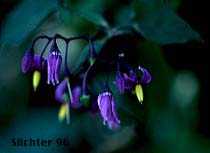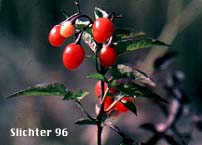
 Characteristics:
Characteristics:
Other synonyms for bittersweet nightshade include scarlet-berry, poison-berry, blue bindweed, snake-berry, woody nightshade or climbing nightshade. It is a weedy, viny perennial with clambering stems up to 3 meters long. The stems arise from rhizomes which are difficult to eradicate from the soil. The herbage of the green stems is generally glabrous but may range to fairly strongly haired. The leaves alternate along the stem and are variable in outline. The blades are ovate and measure up to 12 cm long. The margins are often entire with many leaves with one or two pairs of lobes at the base of of the blade (See photo above.). The petioles are long and slender. The leaves and stems leave a noticeable, bitter odor on the hands when crushed.
The inflorescence is a freely-branched cyme of 5-30 flowers at the end of the peduncle which is 1.5-4 cm long. The pedicels are 5-10 mm long while the short calyx lobes are about 1 mm long and broadly triangular. The corolla is a bluish-purple or deep purple with 5 pairs of greenish-yellow dots below the base of the lobes. The reflexed lobes are triangular-lanceolate and measure from 6-9 mm long. The short corolla tube is about 2-3 mm long. The stamens converge on the style but are not fused to it. The yellow anthers are about 5 mm long. The fruit is a bright red berry that is ovoid-ellipsoid in shape and 8-12 mm long (See photos above and below.).
Bittersweet nightshade is commonly found in disturbed areas under shrubbery in yards, along fences, in ditches, moist thickets, open woods and along water courses. East of the Cascade Mts., it is limited to disturbed, moist thickets or woods.
A native of Europe and Asia, bittersweet nightshade may now be found over much of the United States and southern Canada.
